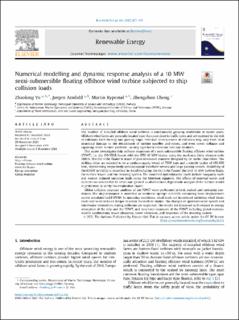| dc.contributor.author | Yu, Zhaolong | |
| dc.contributor.author | Amdahl, Jørgen | |
| dc.contributor.author | Rypestøl, Martin | |
| dc.contributor.author | Cheng, Zhengshun | |
| dc.date.accessioned | 2022-03-28T11:26:53Z | |
| dc.date.available | 2022-03-28T11:26:53Z | |
| dc.date.created | 2022-01-07T12:28:23Z | |
| dc.date.issued | 2022 | |
| dc.identifier.issn | 0960-1481 | |
| dc.identifier.uri | https://hdl.handle.net/11250/2987961 | |
| dc.description.abstract | The number of installed offshore wind turbines is continuously growing worldwide in recent years. Offshore wind farms are generally located near the coast close to traffic lanes and are exposed to the risk of collisions from visiting and passing ships. Potential consequences of collisions may vary from local structural damage to the detachment of turbine nacelles and rotors, and even tower collapse and capsizing of the turbine platform, causing significant economic loss and fatalities.
This paper investigates ship collision responses of a semi-submersible floating offshore wind turbine (FOWT), i.e. the OO-STAR floater with the DTU 10 MW blades, using the nonlinear finite element code USFOS. The OO-STAR floater is made of post-tensioned concrete designed by Dr. techn. Olav Olsen. The striking ships are selected to be a modern supply vessel of 7500 tons and a shuttle tanker of 150,000 tons, representing respectively service/coastal merchant vessels and large passing vessels. Modelling of the FOWT in USFOS is described in detail including the OO-STAR floater, the DTU 10 MW turbine blade, the turbine tower, and the mooring system. The modelled hydrodynamic loads include buoyancy loads and motion induced radiation loads using the Morrison equation. The effects of external waves and currents are assumed to be small and ignored in all directions. Eigenmode analysis of the turbine model is performed to verify the established model.
Global collision response analyses of the FOWT were performed in both parked and operating conditions. The ship resistance is modelled as nonlinear springs in USFOS containing force displacement curves simulated in LS-DYNA. In operating conditions, wind loads are introduced including wind thrust loads and wind induced torque to rotate the turbine blades. The changes of upstream wind speeds and rotor/wake interactions during collisions are neglected. The results are discussed with respect to energy absorption of the ship and the FOWT, and structural responses of the FOWT including global motions, nacelle accelerations, tower clearance, tower vibrations, and responses of the mooring system. | en_US |
| dc.language.iso | eng | en_US |
| dc.publisher | Elsevier | en_US |
| dc.relation.uri | https://www.sciencedirect.com/science/article/pii/S0960148121017213#! | |
| dc.rights | Navngivelse 4.0 Internasjonal | * |
| dc.rights.uri | http://creativecommons.org/licenses/by/4.0/deed.no | * |
| dc.subject | Ship collisionFloating offshore wind turbineOO-STAR floaterEnergy absorptionGlobal response | en_US |
| dc.title | Numerical modelling and dynamic response analysis of a 10 MW semi-submersible floating offshore wind turbine subjected to ship collision loads | en_US |
| dc.type | Journal article | en_US |
| dc.type | Peer reviewed | en_US |
| dc.description.version | publishedVersion | en_US |
| dc.source.pagenumber | 677-699 | en_US |
| dc.source.volume | 184 | en_US |
| dc.source.journal | Renewable Energy | en_US |
| dc.identifier.doi | 10.1016/j.renene.2021.12.002 | |
| dc.identifier.cristin | 1976518 | |
| dc.relation.project | Notur/NorStore: NN9585K | en_US |
| dc.relation.project | Norges forskningsråd: 223254 | en_US |
| cristin.ispublished | true | |
| cristin.fulltext | original | |
| cristin.qualitycode | 1 | |

